If you can't fight the burying instinct – put a mat under the cat's bowl to protect the floor from his claws and absorb the scraping noise.
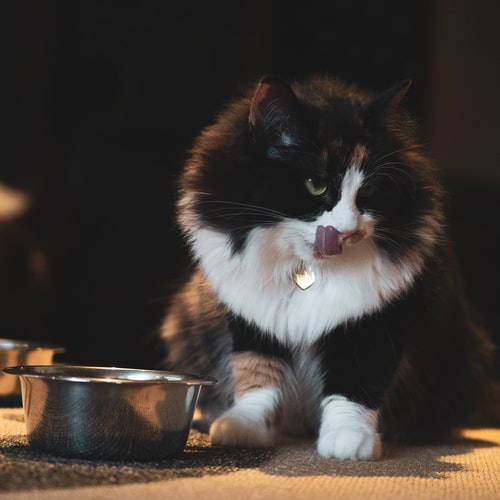
- Why does the cat bury food and scratch with its paw next to the bowl?
- Why does the cat bury food?
- Why does a cat bury food in its bowl?
- How to correct the situation?
- The cat buries the bowl when he eats – it's a matter of instincts
- Save food for later
- Hide from competitors
- Keep it clean
- Reason #4. I won't share!
- Reason #6. No one can know what I ate.
- Why the cat digs at the food bowl
- How to break the cat's habit of burying food
- Read also:
- Why does a cat bury its food bowl and not eat
- 5 mistakes of the owner
- Unpleasant odor
- Unpalatable food
- Uncomfortable bowl location
- Uncomfortable bowl
- Protection from others
- Not enough time to eat.
- Poor quality food.
- How to wean a cat from burying food
Why does the cat bury food and scratch with its paw next to the bowl?
The cat walks up to the bowl, sniffs and. starts burying food with her paw next to it. It's like she's trying to bury the bowl and its contents. Sound familiar?
Cats love a good meal and generally look forward to mealtime. However, the sight of the perfect cat, busily "scratching" next to a bowl full of treats, causes many people to worry. The first thoughts arise: maybe she does not like the food, maybe she should switch to another one? And then: maybe there is something wrong with the cat?
Why does the cat bury food?
As it turns out, scratching near the food bowl is a fairly common occurrence. We once conducted a survey in which we asked users for their interpretation of this behavior. The results of the survey are as follows:
It is important to note, however, that a cat buries food primarily because instinct tells it to do so. Wild ancestors of domestic cats used to bury leftover food in leaves, soil or branches. There were several reasons for this behavior – first, to save some food "for later". The second was to hide the smell that might attract other predators.
Domestic cats inherited this habit, adapting it somewhat to domestic conditions. In addition to the aforementioned motives, a cat that buries food may try to get its owner to give it other food in this way. Following the principle: it worked once, it may work again. If you have unwittingly set a precedent in the past and replaced the contents of the cat's bowl after she scratched it, you must take into account that the cat remembered it.
Don't go down that road. If your cat buries food, don't immediately replace the contents of the bowl. This is an instinctive behavior that usually has nothing to do with a lack of appetite at all – just ignore it. If it happens repeatedly and becomes unpleasant (for example, scratching causes the cat to tip over the bowl and spill the food), you can try giving her smaller portions. If she eats everything every time, she will have no reason to "hide" anything for later.
Remember: burying food, scratching the scratching post and chair, and rubbing your feet are all natural behaviors that serve the same purpose: the cat tags the environment with its scent in order to feel comfortable and safe.
Why does a cat bury food in its bowl?
Pets sometimes perform illogical, in the owner's opinion, actions. For example, right after a meal, the cat buries food in the bowl – why? It turns out that this behavior was necessary for ancient felines to survive.
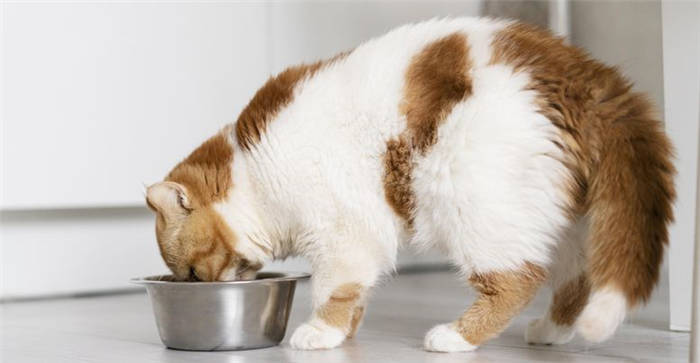
Hunting does not always end successfully, which means there is a risk of starvation. In order to save food "for later", the animal buries it, stocking up. Similar habits manifest themselves in the home. The single portion given can be large for a domestic cat: it doesn't always expend 100% of its energy, which means that the pet doesn't need a large amount of food. Leaving it in the bowl is not possible – instincts urge to hide the food to protect it from the environment and from competitors.
Experts name other reasons why a cat buries a bowl of food, but they are somehow related to natural instincts.
The cat has eaten its allotted portion and is not full. Not feeling full she acts like her ancestors: she begins to "dig out" the food that was "hidden" before. If after giving him another portion the cat eats it, it means he didn't get enough of the food given earlier. You should reconsider the ration and increase the portion. For example, the CRAVE™ brand offers professional cat food rich in animal protein. It supplies the muscles with energy and also contains the amino acids needed for the full development of the animal and to maintain good health. Thanks to the high protein content, the cat will get the energy it needs and everything it needs in each serving.
Sometimes you just need to wait for a moment: perhaps the pet is finicky and will eat the food later. It is worth paying attention to stress factors: for example, a slippery surface on which the bowl stands. It is uncomfortable for the cat to eat in these conditions.
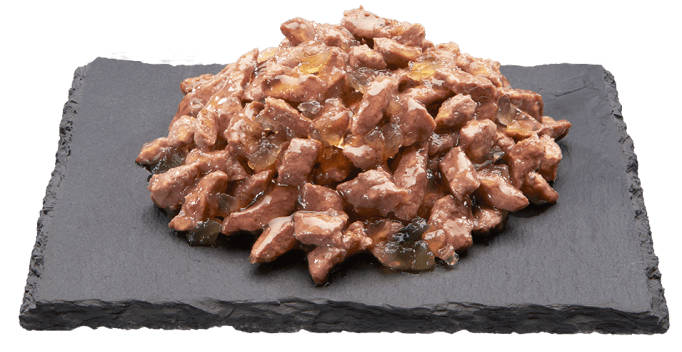
The next reason why the cat buries the bowl after eating is that the place where the food is consumed is not clean enough. Leftover particles of breakfast, lunch or dinner, uncleaned mats under the bowl exude pungent unpleasant smells to the cat's sensitive sense of smell.
How to correct the situation?
Animals, acting on a natural level, signal problems or inconveniences that have appeared. If the reason why cats bury the bowl after eating lies only in too large portions, the situation is easy to correct. There is no need to put more food than the cat will eat at once: it will be exposed to external factors (temperature changes, chafing) and will have to be thrown away. In other cases a comprehensive approach is needed:
- Arrange the feeding area properly.
- Keep the bowl and mats underneath it clean.
- Eliminate and prevent stressful situations. If there are several pets, separate their feeding areas.
- Monitor the quality and expiration date of food. Store cat food correctly: keep open cat food packages tightly covered and avoid placing any odorous products near them.
Cats should not eat food from their owners' table. A balanced diet that includes all the nutrients, vitamins and minerals for your pet's growth and development will eliminate the need to refill the bowl. Choose a quality product, such as CRAVE™.
- It's high in animal protein, micro- and macronutrients, with no added grains;
- No flavorings, colorings, GMOs;
- Variety of flavors;
- Quality raw materials from proven suppliers: turkey, chicken, salmon, lamb, beef, rabbit;
- Natural ingredients that promote better digestion of food: minerals, vegetable oils, extracts of chicory and rosemary, dried vegetable pulp.
The cat buries the bowl when he eats – it's a matter of instincts
According to experts, pets bury under-eaten food on an instinctive level, which is due to their descent from wild cats.
Save food for later
In the wild, this is how predatory animals behave, interested in hiding their prey or what is left of it for later. This is how they make a reserve, so that in case of unsuccessful hunting they will not go hungry.
Household cats do not have such problems, because a caring owner will always give you a portion of your favorite treat in time. But cats don't understand this, so they instinctively try to bury the rest of the food or the whole portion given out to protect themselves just in case.
Hide from competitors
Another innate instinct of domestic cats is to hide tasty food from competitors. Animals have a very well-developed sense of smell, and it is by smell that they look for their prey. If after a tasty snack the cat buries the remains of food, it is possible that in this way he is trying to minimize its fragrant smell, so that other pets do not get to his supply.
Keep it clean
Cats are very clean animals. Many of them bury food in order to clean up the very place where the pleasant process of eating takes place. If the cat does it all the time, it is likely that cleanliness is the reason for such actions. How to teach the cat to bury food: ways and tips In conclusion of the article, we will give some useful tips for owners, thanks to which you can teach the animal to dig the floor near the bowl with food.
- Do not give the cat food that she does not like. Be sensitive to her likes and dislikes.
- Determine the right portion. Do not overfeed your cat or give him too much food to eat in one sitting so that he won't have to throw it in the trash.
- Feed regularly so he doesn't starve, which can cause him to stockpile for later.
- Control the situation when the cat is eating. If she starts to behave atypically, try to determine the reason for this behavior.
- If the cat started digging after replacing the bowl with a new one, remove it and change it for another. Observe the situation. If the cat stops burrowing, then the unrecognized bowl is the cause. ⦁ Pour the food into a clean bowl.
- Make a comfortable place for the cat to feed, always keep it clean.
Reason #4. I won't share!
It's a similar story if you have more than one pet living in your house. In that case, the cat, burying food, simply does not want to leave food for a competitor. Be sure to put personal bowls for each pet so there is no conflict and these attempts to "stock up for the winter."
The most interesting thing is that the cat can dig near the bowl, wanting to. dig up the food that he seems to have buried here yesterday. This behavior is exhibited by a pet that has not had enough to eat. In nature, it is common for cats to bury and then dig up food. The cat may have developed a false memory.
Reason #6. No one can know what I ate.
Instinct is another explanation for a cat's strange behavior. It all comes from wild ancestors who always buried food scraps to avoid attracting other animals to their territory.
If your cat has water next to his food, he may have accidentally spilled it. And when it sees the puddle it might get frightened: what if the owner suspects that the puddle was bad. In this case, the cat will bury and smear the water, to cover the tracks of its "crime. In general, a bowl of water near a bowl of food is a bad idea. Often the animal just stops drinking from such a bowl of water, preferring to catch drops from the faucet. Or. climbing into the owner's mug.
Why the cat digs at the food bowl
When a cat buries its food bowl, it is guided primarily by its instincts. But this behavior can have different reasons.
- Poor-quality or unpalatable food. If the cat, after smelling the food in the bowl, does not even touch it and starts to bury it immediately, it means that there is something wrong with the food. Perhaps it is spoiled or simply does not like the cat. Many people think this is the only reason that makes our pets bury the bowl. But this is more of one of the myths about cats.
- Too much food. If there is more food in the bowl than the cat needs, he will decide to save the rest for a rainy day. This is where instinct kicks in, and the animal starts covering the bowl with invisible earth.
- The problem is in the bowl. If your pet refuses to eat any food, it may just not be the right bowl. It may be too low or, conversely, too high. Narrow bowls with high edges are unlikely to please your cat: she will touch the edges of the bowl with her vibrissae and feel uncomfortable about it.
- Clutter around the eating area. Cats are extremely clean and they have an excellent sense of smell. Stale food, dirty floor by the bowl – all this may not please the graceful beauty, and she will show it by arranging "excavations". A similar problem, by the way, may be one of the reasons why the cat will not want to drink water from the bowl.
- Not enough food. If a cat is systematically not getting enough to eat, it will try to save food for hungry times and leave it on purpose.
- Stress condition. Stress can prevent the cat from eating normally, so it will hide food for later.
- Competition. If there are several animals living in the house, even friendly ones, the instinct can make the cat hide food from the "rivals".
How to break the cat's habit of burying food
To help the cat get rid of this habit, you need to understand and eliminate the cause of burying:
- Give only quality food that is suitable for the cat;
- Choose a bowl that suits the cat;
- Keep the bowl and the area around it clean;
- try to give your pet food on time and in the right amount;
- eliminate the causes of stress;
- Arrange feeding areas for other pets separate from the cat.
Understanding this behavior will help to establish the pet's life. And then unnecessary digging can be forgotten.
Read also:
Why does a cat bury its food bowl and not eat
If you notice that the cat scratches the floor next to the bowl, makes the same movements as after going to the toilet, you should not film and laugh at the animal. Cats' behavior is driven by nature, everything they do is rational from their point of view.
The animal plays, because it is a training of hunting instincts, sleeps a lot, because you need to conserve energy for the hunt and the search for prey. Burying food also happens for a reason.
Let's break down the reasons for the strange behavior of the pet. They can be divided into 3 groups:
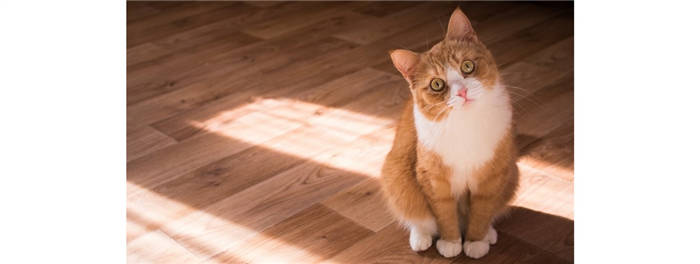
5 mistakes of the owner
Cats are some of the cleanest animals. They can "wash" up to 15 times during the day, and are intolerant of breaches of hygiene, unpleasant odors and food spoilage. The place of food consumption is also important for them. Therefore, if the cat buries a bowl of food, it is worth analyzing the conditions you have created for him.
Unpleasant odor
Cats have a very sensitive sense of smell, so they are much more sensitive to smells. Any unpalatable or pungent smell causes the animal to reject it. The cat will sense at once if the food offered by the owner is spoiled or cured, and will not eat it.
The cat expresses its displeasure like a child – with demonstrative behavior. He may meow unhappily or dig his paw diligently around the bowl as if he were going to the bathroom, and won't touch the food.
If you feed him dry food, follow the rules for storage and feeding. Don't leave uneaten food in the bowl. It gets stale and oxidized, loses its nutritional properties and does not attract the cat with its delicious smell. Keep your cat on a feeding schedule so he gets enough to eat and doesn't leave any leftovers in his bowl.
Unpalatable food
If you offer the cat new food and it refuses to eat it, it means that it does not like it. In this case the cat will bury the food, wanting to show you its dislike. Remember that cats are free-loving animals with their own personality and food preferences. At the same time they are rather conservative: they prefer to eat proven food, which they consider safe, and they do not like sudden changes in diet.
If you're transitioning your pet to a new diet, do it gradually, adding the new food to the old and slowly increasing the ratio. We talked about the rules for switching in this article. The same rules should be followed when switching from natural food to dry food.
If the cat continues to refuse food and actively "digs" at the bowl, don't force her to eat something she doesn't like.
Uncomfortable bowl location
If the cat is burying food, it can be assumed that this is due to an awkward or improperly positioned bowl. If this is the case, the cat is pointing out to the owner what she is uncomfortable with. Perhaps the cat doesn't like the smell, the sounds made by appliances in the eating area, or everything has to do with drafts – if the bowl is close to windows or the front door.
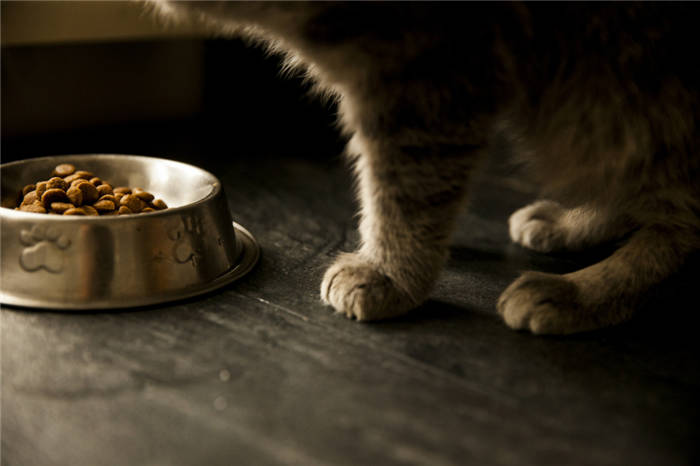
Try moving the plate the cat is eating from. Perhaps after the first or second rearrangement she will stop hoarding her food.
Uncomfortable bowl
As strange as it may sound, animals also care about comfort. This includes the utensils from which the pet takes his food. If he's uncomfortable eating from the owner's suggested option, it's likely that food in the bowl will be buried until a new utensil is purchased.
Choose a cup that is not too deep and corresponds to the size of the animal. The preferred material is metal or ceramic. Plastic gives off a faint odor and the cat will immediately refuse it. An auto-feeder can be a good purchase.
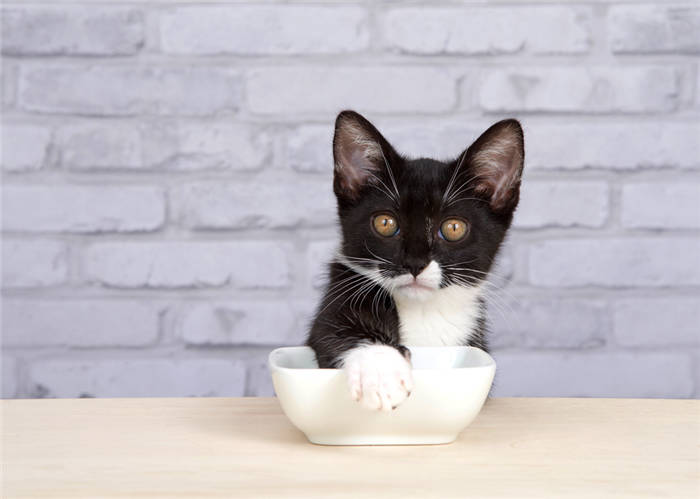
Protection from others
If there are two or more cats in the house, or if a dog lives with them and steals cat food, cats may try to protect their food from others. This is closely related to trying to put food away for later. They can't eat everything at once, but they know that if they leave the food behind, a dog will come and snare them. In the wild, cats bury leftover food so they can come back when they get hungry, confident that other animals won't find them.
If a cat has recently had kittens or if there is both a mother cat and her young kittens in the house, the adult cat may try to leave food for the kittens. Cats are mothers by nature, so they will do everything they can to make sure their kittens eat and stay healthy. A constant supply of good food is very important for the health of kittens, and the mother cat knows it!
Not enough time to eat.
They don't have enough time to eat. Cats usually take a little longer to eat because they don't devour food as quickly and furiously as dogs do. You may worry that the cat won't have time to eat its food before it is picked up.
This problem is common for cats that have set meal times and does not apply to cats that are out grazing all day. It may seem like your cat is skipping meals, but if you give her a little more time to finish her meal, you'll both be happy.
Poor quality food.
Cats usually sniff it first before eating. If the cat won't touch the bowl of food and even tries to bury it, it means she doesn't like the food. For example, a cat may "reject" slightly spoiled or lethargic food, as well as refuse to eat from a dirty bowl.
By nature, all members of the feline family are cleaners. If they don't like the smell of food, they try to get rid of it quickly. Sometimes the cat buries food because it tries to dispose of it as the contents of a dirty litter box, because food should always be appetizingly smelling and fresh.
How to wean a cat from burying food
Most owners aren't thrilled with their cats' habits of raking their paws near the bowl before or after eating. It is quite realistic to wean a cat from burying food. To do this, you need to:
- Feed the cat little by little, but often, and observe what and in what amounts it eats.
- Clean up the bowl of leftovers after the cat has finished eating.
- Distract the cat by playing, for example, if the owner notices that the pet is about to bury food.
- Change the location of the eating area. Cats don't like having a litter tray next to their bowl or a faucet with water constantly flowing from it.
- Adjust the cat's diet – choose a quality cat food. Heat up food, add flavored cheese, or sprinkle chicken broth on it to whet his appetite and attract his attention.
- Keep his bowls and eating area clean, but do not wash them with strong-smelling household chemicals.
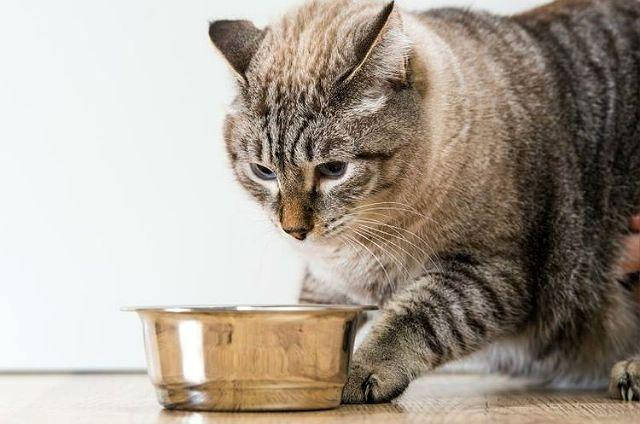
Every owner should be able to understand his cat. If she suddenly begins to bury her food bowl, you need to observe the pet to find out the reason for this behavior.
Sometimes cats have this habit almost from birth. In this case, it is better to leave the pet alone and not try to wean it from burying its food or find out why it is doing this – because this is just a cat's instinct.






